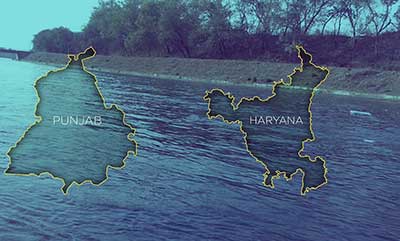By Opinion Desk | May 1, 2025
The intensifying water dispute between Punjab and Haryana has reached a critical stage. With the Bhakra Beas Management Board (BBMB) recently approving the release of 8,500 cusecs of water to Haryana on humanitarian grounds, tensions have boiled over into mass protests led by Aam Aadmi Party (AAP) leaders in Punjab.
While Haryana justifies its request as essential for drinking water, Punjab claims its own survival is at stake. Dam levels across Bhakra, Pong, and Ranjit Sagar are dangerously low, prompting fears of a severe power shortage during the upcoming paddy cultivation season.
Water Levels Falling, Tensions Rising
Official data paints a grim picture. The Ranjit Sagar Dam is currently at 502.19 metres, down from 506.12 metres last year. Bhakra has dropped over 11 feet, while Pong is nearly 32 feet lower than its corresponding level in 2024. Punjab’s hydroelectric output is already suffering, with the 600 MW Ranjit Sagar plant underperforming. Punjab’s estimated summer power demand stands at 17,300 MW, but the state expects to generate only about 6,000–6,500 MW.
The Central Water Commission confirms that reservoir storage is down 40.67% in Himachal Pradesh and a staggering 44.85% in Punjab compared to the decadal average. Climate change—manifesting as reduced snowfall, erratic rainfall, and rising temperatures—is disrupting the region’s entire hydrological rhythm.
Political Theatre Amid Ecological Crisis
The war of words between Punjab Chief Minister Bhagwant Mann and Haryana CM Nayab Singh Saini has turned the water debate into a political flashpoint. Mann called the BBMB decision an “act of plunder,” while Saini accused AAP of “political hypocrisy”—silent on Haryana’s water rights in Delhi, loud in Punjab.
Haryana claims it is under-utilising its quota, while Punjab counters that Haryana has already exceeded 104% of its allocation for the current cycle. Meanwhile, ordinary citizens suffer, caught between failing infrastructure and political gamesmanship.
Why the Centre Must Step In Now
Experts warn that this is not a localized issue—it is a national crisis in disguise. The stakes go beyond water and electricity. If unused water from Indian reservoirs continues to flow into Pakistan through the Harike-Pattan barrage, it undermines India’s geopolitical interests.
What’s needed is not more shouting, but statesmanship. The central government must act as a neutral mediator and implement a climate-resilient water governance framework. This includes:
- Real-time reservoir monitoring and public dashboards
- AI-integrated weather prediction and usage forecasting
- Transparent, data-backed water release decisions
- Equitable water-sharing based on changing climatic realities
Time for Bridges, Not Barbs
This is a moment to unite around a shared threat, not divide for political gain. As PM Modi recently warned in the context of national security, India must respond with resolve. That same urgency must apply to water security. Let us stop shouting across the dam—and start building a bridge over it.
Water is not just a state resource; it is a national lifeline. It feeds our fields, powers our homes, and defines our diplomacy. Managing it demands cooperation, not conflict. This moment demands unity, not blame.
For related analysis, read our article on India’s Climate-Driven Energy Challenges.


